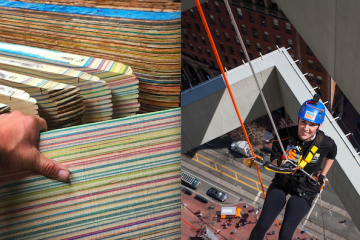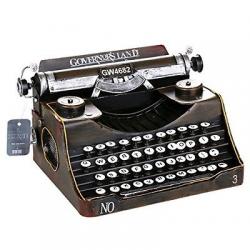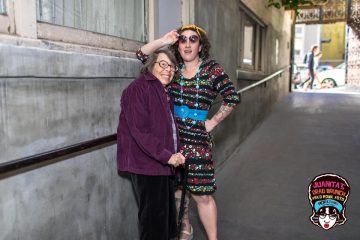Angry About the MTA? Let’s Talk About SEPTA
By Hannah Harkness
This summer is being referred to as “The Summer of Hell” by MTA riders. Line closures, derailments, fires and late trains are making everything insane for public transit riders.

A recent cover of The New Yorker depicts NYC’s feelings towards its mass transit. Image via this site.
But as I look at the images of giant throngs of stranded riders popping up on my Facebook feed, I feel compelled to remind New Yorkers of how good they have it. Why? Because I’m a lifelong Philadelphia resident and SEPTA rider.
Going into this, I will 100% cop to “Philly has a version of a New York thing that is dirtier, poorer and worse” is not news. Of course, it isn’t. We’re your red-headed stepchild with less money, millions of fewer people, and we were recently rated by Huffington Post as the angriest city in America (AND WE’RE PROUD OF IT! YOU GOT SOMETHING TO SAY, SHITBIRD?!)

“It’s Always Sunny In Philadelphia” get’s it right. Courtesy of 3 Arts Entertainment
I love New York, which is why I am relocating there, but I’m always going to have the “Oh, you think THAT’S bad? LET’S TALK ABOUT PHILLY” chip on my shoulder until I die from a cheesesteak related cardiac arrest. So in hopes that you count your blessings, New York, let’s talk about the South Eastern Pennsylvania Transit Authority, or as my mom interprets the acronym, “Sometimes Everybody Parks Their Ass”.
One of SEPTA’s biggest hulking issues is that we more or less have two subway lines, the Broad Street Line and the Market Frankford Line, one north-south, one east-west.
Two. For the sixth most populous city in the country.
While the area of Philadelphia most people visit is relatively walkable, it’s important to remind out of towners that the consolidated area of the city/county is 142 square miles. So when people in New York complain that a train is down and they have to switch to another train, I find myself going in my head “at least you have another train and not just ‘the other train”.
This is a problem we got stuck with because of the decisions of a bunch of morons in the early 1900’s who did not listen to the original commissioner of the new Department of City Transit.
A. Merritt Taylor, appointed in 1912, was a visionary that had a series of plans that involved way more than one subway going north to south and the other going east to west. He was regarded by transit planners as being very far ahead of his time. In 1916 he was fired for producing plans that were too expensive and replaced with William S. Twining who believed that there should only be subways in places that proved profitable. Debates on which subway lines would be profitable gridlocked in city government. WWI created a labor and material shortage that severely limited what little mass transit expansion efforts had been approved.
Twining’s influence also created issues with the Philadelphia Rapid Transit Company, the predecessor of SEPTA rejecting proposals for any subway line that they thought wouldn’t make money or would compete with one of their trolley routes. Philadelphia did not move ahead with mass transit expansion in the face of the depression like New York did. There was an attempt in 1929 when the mayor authorized a 55 million dollar loan for a 10-year mass transit expansion plan that would have added several subway routes, but the loan never actually materialized. When the city’s finances turned around post WWII, all the infrastructure improvement focus went toward highways and urban renewal efforts.
So because people didn’t listen to a guy in 1912, we are here over a century later with two subways, a smattering of above/underground trolleys, regional rail trains out to the suburbs.
(the closest I can compare these to is NYC is the LIRR), and buses transporting over a million people. Unsurprisingly, it’s overcrowded, everything is constantly breaking down or under construction and delays are just the law of the land. We don’t have fancy screens reliably telling you what time things are showing up at most of the stops either, you’re just going to have to wait and pray.
Let’s talk payment! In New York, it’s pretty straightforward. You have a card. You put money on it. The money lets you get on the train or the bus. We have a similar thing called a SEPTA Key, but we’ve only had it for about a year.
The SEPTA key only applies to the buses and subways/ trolleys (the regional rail trains are a separate issue that I will get into later in this article). The SEPTA key is a reloadable plastic card that works pretty well, but if you don’t want to get a reloadable card and just a single fare, you have to buy a single fare card that only works at the station you are getting on at, and you can’t save it and use it somewhere else.
Before the SEPTA key happened, your options were tokens, cash, and passes. Somehow, until this year, this city was still using tokens. You bought packs of them from the office, if the office wasn’t closed, or if you got lucky and the machine was working. There is no guarantee there would be an open office or a working machine anywhere you get on the bus or subway. The token machines did not accept cards, and whether or not a SEPTA office would accept cards was a crapshoot. If you can’t buy tokens, you could pay cash but only if you have 2.25 exact change. You can still do this now if you don’t have a SEPTA key, or if the SEPTA key machine isn’t working. You can also still turn in tokens if you still have them, but they aren’t selling new ones.
Transfers aren’t always free like on the MTA. You only get a free transfer if you are going subway to subway or subway to the underground trolley (the above ground trolley doesn’t count, sucker!). If you want a transfer between a bus and another bus or a bus and a subway/trolley, you have to pay an extra dollar and they give you a paper transfer slip that you can’t lose otherwise you’re going to have to pay another fare. The transfer slip is only good for one day and one transfer.
Does your head hurt yet, New Yorkers? I haven’t even scratched the surface.
Let’s talk passes! You can buy a one day pass called an Independence Pass that lets you get on anything, but only if you can find an office that sells them that happens to be open at the moment that you want one. These passes are $12 and someone has to hole punch the date in them to indicate that it’s only good for that day. They can’t be swiped, you always have to physically show it to a SEPTA employee to get on something.
Before the SEPTA key, we had weekly and monthly passes for bus/ subway. Thankfully, they’ve been phased out (not the Independence pass, just the weekly/ monthly-come on now, it’s not fun if it isn’t cripplingly confusing!). The main problem with these was that you were only allowed to buy them in a certain time window. If you didn’t buy your monthly pass at the beginning of the month, you had to buy weekly passes. If you didn’t buy your weekly pass on Sunday or Monday, you were forced to pay single fares the rest of the week. That meant you were walking around for a week with a piggy bank’s worth of tokens and a stripper wad of singles for transfers.
I told you earlier I was going to get into the regional rail, and here we are. This is the fun part-if you use the regional rail out to the suburbs, NO SEPTA KEY FOR YOU!
You still have to use the SEPTA passes that are only available to purchase at certain times. There is no guarantee that your train station will have an office that sells them, or that the office will be open when you are there. If you miss the window for buying your pass, you have to buy a paper ticket collected by a train conductor. If you don’t have a ticket, you have to buy it on the train. You will get hit with a surcharge for buying tickets on the train regardless of whether or not your train station has a ticket office that is open (read: sometimes your only option is to get hit with a punishment fee for something you had no shot at avoiding).
You can only pay cash on the train. The fare is higher during peak hours-if you buy an off-peak ticket at the office and try to use it during peak hours, they will make you give them the additional money on the train. The fare is also higher depending on what zone your destination is in. I currently live in Zone 3, which means that there are two ticket price hikes that happen before I get to where I live. My weekly pass is a zone 3 pass. If I want to go to zone 4, I have to pay an additional fee on the train. If you mess up anything and you’re not adorable enough to plead on the employee’s good will, you’re kicked off the train.
Courtesy of Paramount Pictures
Now that we’ve covered the clusterfuck that is “how do I pay to get on public transit in your city”, which usually is a question that has a short answer but somehow just warranted several paragraphs, let’s talk about some of the other fantastic issues Philly has that NYC doesn’t!
SEPTA isn’t 24 hours! Not at all. The two main subway lines are 24 hours only on Fridays and Saturdays, which is a fairly recent development. If you miss the last regional rail train out to the burbs, usually around 12:30-1AM, you are stranded until 5 am.
Earlier I mentioned that a lot of stations don’t have signs that tell you when things are coming. Even when they do, I don’t really trust them. I’ve watched signs fluctuate from “train arriving in 5 minutes” to “15 minutes” then “on time” then “8 minutes” right as the train shows up on the platform. If they know something is going to be late, sometimes they will play a canned recorded announcement “train x is reported to be 5-10 minutes late-please stay on the platform as this is only an approximate time”. The screen, which may or may not exist, or may or may not actually be working, might not say the same thing as the announcement.
You guys also have trains simply marked with numbers, letters, and colors! That’s pretty cool and makes total sense. We, however, can’t be bothered. The two main subway lines, in theory, could be called the blue line and the orange line, but they are usually called the Market Frankford Line and the Broad Street Line. The Market Frankford Line is colloquially referred to as the “El” which is short for “Elevated train”, not to be confused with the letter L, which is a bus in North Philly that you more than likely have no reason to ever go near unless you have family over there.
Lord help you if you transit map that shit by accident when someone tells you to get on the El, tourist! The trolleys and buses have numbers and letters, thank God. However, all of the underground/ above ground trolleys are somehow called “the green line”. “Line” usually means something has a single beginning and end, not one beginning and several ends including West Philadelphia, farther-reaching suburbs and stuff near the airport. But, hey, what do I know? I’m not a transit planner!
The regional rail *used* to have numbers. Boy, do I miss those days. When I was growing up though, there were trains R1, R2, R3, R5, R6, and R7. Notice something missing? Yup, no R4-that had been phased out by the time I started riding. A GREAT way to mess with out of towners when I was a kid was to tell them to get on the R4 & somewhere. But one day, that all changed and all of the numbers were swapped out for signs that were all the same color and the lines were re-named after the end destinations. For example, the R3 is now the West Trenton line. But even though the end destination is the name of the train line, sometimes that train doesn’t actually go all the way to the end destination. The train line that goes to Wilmington, Delaware doesn’t do that after a certain hour and magically becomes the Marcus Hook train.
Also, keep your eyes on the train schedule-just because a stop happens to be on the train line you are on doesn’t mean that the train has to stop there EVERY TIME, that’d be just too goddamn easy!
Sometimes there are “flag stops”-you actually have to tell someone that you need the train to stop as if it were a bus, but not as easy as a bus because there is no button to press. Also, sometimes the train will only stop there at certain times. There are express trains on commuter times, too! What, you didn’t know this wasn’t going to stop anywhere you needed to go? Well, missy, you should have been paying attention to the part when the train conductor slammed the door and yelled: “WE’RE NOT STOPPING AT ELKINS PARK”.
MTA riders are currently complaining about a number of trains being taken out of commission/ dealing with shuttle buses. I honestly can’t remember a year when I haven’t had to deal with a shuttle bus several times for virtually every form of SEPTA train or trolley when they needed maintenance.
Last summer we had a lot of really fun regional rail issues because 120 of the fancy new cars they had recently rolled out had to be taken off the rails due to factory defects. SEPTA in their infinite wisdom had gone with the lowest bidder for manufacturing the new cars and they were crap. By the time they discovered the defect, the manufacturer had already gone out of business. This was a summer of delays and shuttle buses galore.
Another fun thing! There are several entrances to stops that shut down during certain hours of the day, leaving you hovering around the area where you know the train is trying to figure out how the hell to access it. Navigating Suburban Station/ City Hall after 10 pm is like trying to find where the train is leaving in the middle of an MC Escher drawing.

An accurate depiction of how it feels to navigate SEPTA. “Convex and Concave” by MC Escher. Image from here.
A separate article could be written about SEPTA’s administration/ union that I honestly would have to research much more before writing. Most of my knowledge is based on my experience. I’m not versed in the union struggles or what SEPTA employees deal with, all I know is that SEPTA strikes happen periodically and they leave all of us walking, driving, and taking cabs in gridlock. I’ve had friends lose jobs during SEPTA strikes because they couldn’t get to work. The most insane thing the administration has done in my opinion is not paying property taxes for several years on the commercial real estate surrounding Suburban Station. The biggest central transit hub because, and this is a real quote from the real estate director Gerald Maier “I thought we didn’t have to”.

Image via this site.
The back taxes totaled $22 million and would have gone to municipal improvements. All of that debt was washed clean by the city in 2014 in exchange for a promise to make improvements to the concourses and SEPTA had to pay the city $100. The $100 is what gets me-the back taxes were $22M, a SEPTA tote bag and a $20 gift card would have had the same effect on the city’s finances.









